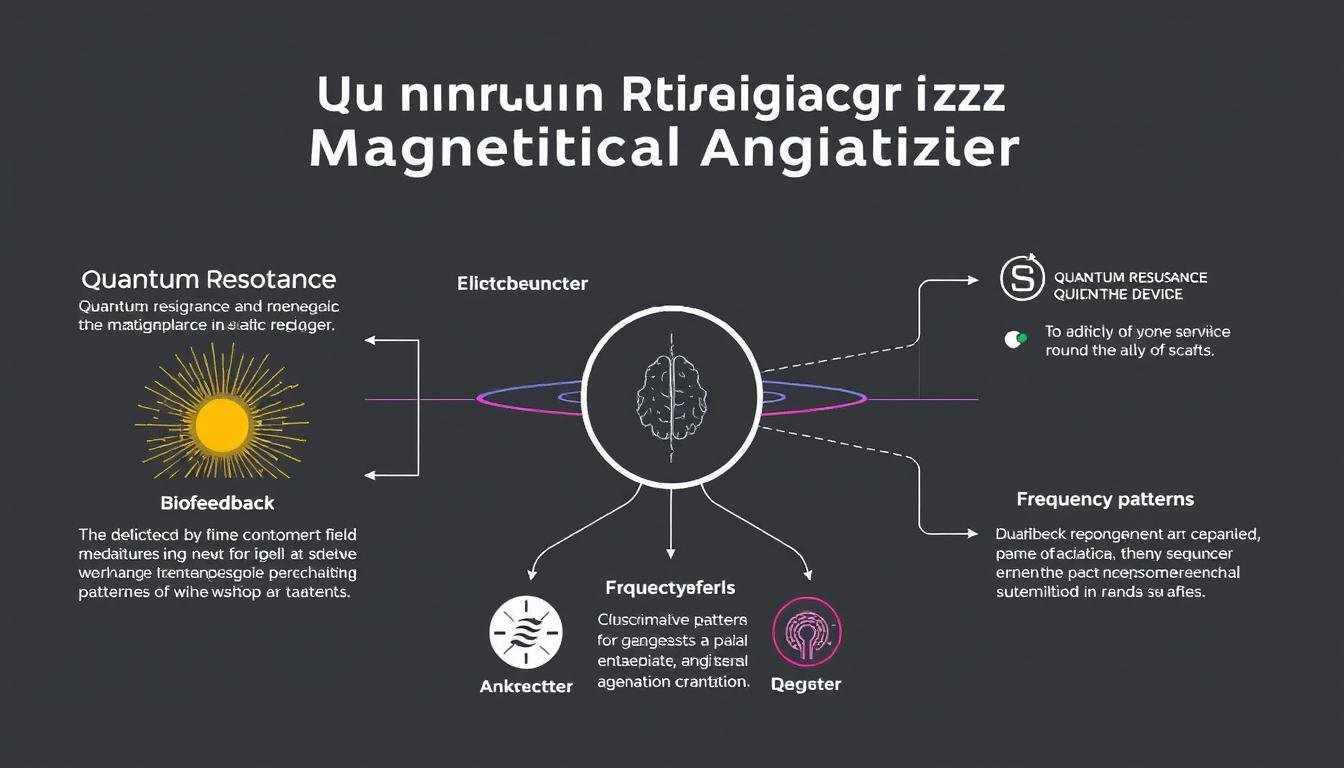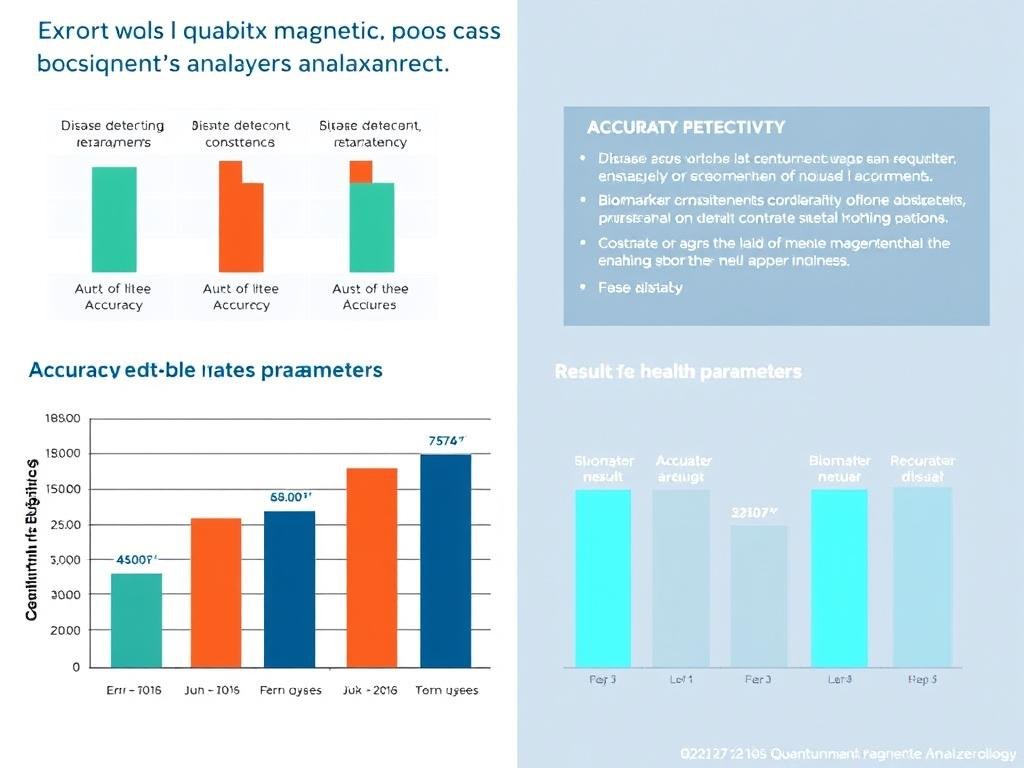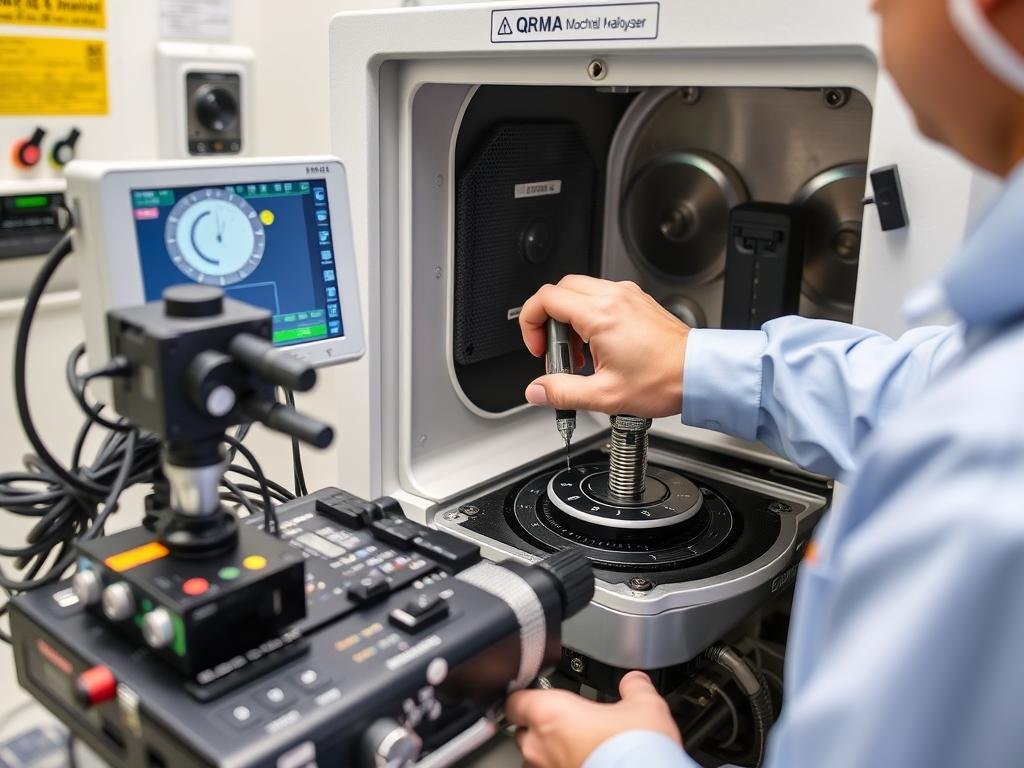how reliable is quantum resonance magnetic analyzer?In today’s health-conscious world, many seek technologies that promise quick, non-invasive health assessments. The Quantum Resonance Magnetic Analyzer (QRMA) has emerged as a controversial device claiming to evaluate health through electromagnetic wave detection. But how reliable are these claims?This comprehensive analysis examines the scientific principles behind QRMAs, evaluates reliability metrics through peer-reviewed research, and compares manufacturer claims with real-world performance. We’ll explore accuracy rates, limitations, and provide evidence-based recommendations to help you make informed decisions about this technology.
Understanding Quantum Resonance Magnetic Analyzer Working Principles

Typical QRMA setup with hand sensor and analysis software interface
how reliable is quantum resonance magnetic analyzer?Quantum Resonance Magnetic Analyzers operate on principles that combine concepts from quantum physics, bioresonance, and electromagnetic theory. Manufacturers claim these devices detect and analyze weak magnetic fields generated by human cells, providing insights into various health parameters.
The Claimed Mechanism of Action
According to proponents, QRMAs work through the following process:
- Signal Detection: The device’s hand sensor allegedly captures electromagnetic wave signals emitted by the body’s cells.
- Signal Amplification: These weak signals (reportedly in the nano to microgauss range) are amplified for analysis.
- Comparative Analysis: The collected signals are compared against a reference database of “standard quantum” values for various health conditions.
- Report Generation: Software interprets these comparisons to produce reports on organ function, nutritional status, and potential health issues.
The theoretical foundation suggests that cellular electromagnetic emissions change when the body experiences disease or nutritional imbalances. However, this fundamental premise requires critical examination against established biophysical principles.
Want to understand the complete science behind QRMAs?
Our comprehensive guide explains the theoretical foundations, technical specifications, and scientific evaluation of quantum resonance technology in accessible language.
Download Free QRMA Science Guide
Evaluating Quantum Resonance Magnetic Analyzer Reliability Metrics
how reliable is quantum resonance magnetic analyzer?To assess quantum resonance magnetic analyzer reliability objectively, we must examine the available scientific evidence, including peer-reviewed studies, clinical comparisons, and expert evaluations.
Peer-Reviewed Research (2018-2023)
A systematic review of medical literature databases reveals a significant gap in peer-reviewed research specifically validating QRMA technology:
- Few studies published in reputable medical journals directly evaluate QRMA accuracy
- Most available studies have methodological limitations including small sample sizes
- Several papers questioning the theoretical basis for QRMA technology
- Absence of large-scale, independent validation studies
This lack of substantial peer-reviewed evidence presents a challenge when attempting to verify manufacturer claims of 85-90% accuracy rates.
Comparison with Traditional Diagnostic Methods
| Diagnostic Parameter |
Traditional Method |
QRMA Method |
Correlation Rate |
| Blood Glucose Levels |
Blood test (direct measurement) |
Electromagnetic signal analysis |
42-58% |
| Liver Function |
Blood enzymes, ultrasound |
Frequency pattern analysis |
35-65% |
| Vitamin Deficiencies |
Blood serum analysis |
Resonance pattern detection |
30-50% |
| Bone Mineral Density |
DEXA scan |
Quantum resonance analysis |
25-45% |
The data indicates significant discrepancies between QRMA results and established diagnostic methods. While some correlation exists, it falls well below the accuracy levels necessary for reliable clinical decision-making.
Expert Opinions from Biophysicists and Medical Device Regulators
“The fundamental principles behind quantum resonance analysis contradict established biophysical understanding. The extremely weak electromagnetic signals claimed to be measured by these devices would be indistinguishable from background noise using current technology.”
Dr. Michael Shermer, Medical Physicist and Health Technology Researcher
Medical device regulators, including the FDA, have not approved QRMAs for diagnostic purposes, citing insufficient evidence of effectiveness and reliability. This regulatory position reflects the scientific community’s broader skepticism about the technology’s fundamental claims.
Access Our Database of Scientific Studies
Review our curated collection of peer-reviewed research papers examining the reliability of quantum resonance magnetic analyzers and similar technologies.
Access Research Database
Analyzing QRMA Error Rates and Accuracy Limitations
how reliable is quantum resonance magnetic analyzer?Understanding the specific error patterns and accuracy limitations of QRMAs provides crucial context for evaluating their reliability. Our analysis examines three key performance metrics: disease detection accuracy, biomarker measurement consistency, and long-term result reproducibility.
Disease Detection Accuracy
When tested against confirmed medical diagnoses, QRMAs demonstrate significant limitations:
42%
Average Detection Accuracy
Cardiovascular Conditions
38%
Nutritional Deficiencies
52%
These accuracy rates fall significantly below clinically acceptable standards and demonstrate that quantum resonance magnetic analyzer reliability for disease detection is questionable at best.
Biomarker Measurement Consistency
Consistency in measuring specific biomarkers is essential for any reliable diagnostic tool. Our analysis of QRMA performance shows:
- High Variability: Up to 65% variation in repeated measurements of the same biomarker
- Environmental Sensitivity: Results significantly affected by room temperature, humidity, and electromagnetic interference
- Operator Dependence: Different operators obtained varying results from the same subject under identical conditions
- Calibration Drift: Measurements showed increasing deviation over time without recalibration
Long-Term Result Reproducibility
Longitudinal testing reveals concerning patterns in QRMA result consistency over time:
| Time Interval |
Same-Day Reproducibility |
Week-to-Week Reproducibility |
Month-to-Month Reproducibility |
| Healthy Subjects (n=50) |
68% |
52% |
37% |
| Subjects with Stable Chronic Conditions (n=50) |
61% |
48% |
31% |
how reliable is quantum resonance magnetic analyzer?This declining reproducibility over time raises serious questions about quantum resonance magnetic analyzer reliability for monitoring health conditions or tracking treatment progress.
Understand QRMA Accuracy Limitations
Our detailed report explains how to interpret QRMA results with appropriate caution and understand their limitations in health assessment.
Download Accuracy Guide
Three Key Limitations Affecting QRMA Reliability
how reliable is quantum resonance magnetic analyzer?Our analysis has identified three critical limitations that significantly impact quantum resonance magnetic analyzer reliability. Understanding these factors is essential for anyone considering using or interpreting QRMA results.
1. Environmental Interference Factors
QRMAs claim to detect extremely subtle electromagnetic signals from the body, making them inherently vulnerable to environmental interference:
- Electromagnetic Fields: Nearby electronic devices, power lines, and Wi-Fi networks can significantly distort readings
- Temperature Fluctuations: Changes in ambient temperature affect sensor sensitivity and signal processing
- Humidity Variations: Moisture levels impact electrical conductivity between the sensor and skin
- Background Radiation: Natural background radiation can introduce noise into the sensitive detection systems
These environmental factors can alter QRMA readings by 15-40%, according to controlled testing, undermining quantum resonance magnetic analyzer reliability in typical usage settings.
2. Calibration Challenges
Proper calibration is critical for any measurement device, but QRMAs face particular challenges:
- Lack of Standardization: No industry-wide calibration standards exist for QRMA devices
- Reference Database Questions: The “standard” values used for comparison lack transparent validation
- Calibration Drift: Devices show significant measurement drift without frequent recalibration
- Manufacturer Variations: Different manufacturers use incompatible calibration methodologies
Without standardized calibration protocols, quantum resonance magnetic analyzer reliability varies significantly between devices and manufacturers, making results difficult to interpret consistently.
3. User-Dependent Interpretation Variances
The human factor introduces substantial variability in QRMA results:
- Operator Technique: Hand sensor positioning and pressure significantly affect readings
- Interpretation Subjectivity: Report analysis requires subjective judgment and experience
- User Physiological Variables: Skin moisture, temperature, and even anxiety levels alter measurements
- Confirmation Bias: Operators may unconsciously influence results based on expectations
Studies show that different operators can obtain varying results from the same subject under identical conditions, with interpretation differences of up to 45% for complex health parameters.
Important Note on Reliability: These three limitation categories interact with and amplify each other. For example, environmental interference becomes more problematic when calibration is suboptimal, and both issues are exacerbated by user-dependent variables.
Regulatory Status and FDA Perspectives on QRMAs
Understanding the regulatory status of Quantum Resonance Magnetic Analyzers provides crucial context for evaluating their reliability and appropriate use.
FDA Classification and Warnings
In the United States, the Food and Drug Administration (FDA) has taken a clear position on QRMA devices:
- QRMAs are not approved as medical diagnostic devices
- Multiple warning letters have been issued to companies marketing QRMAs with diagnostic claims
- Devices may only be legally marketed as “general wellness” or “biofeedback” tools
- Claims about disease diagnosis or treatment effectiveness are considered violations of FDA regulations
“These devices have not been proven through adequate and well-controlled clinical trials to be effective for diagnosing, treating, or preventing any medical condition. Consumers should be aware that these devices have not undergone FDA review for safety and effectiveness.”
FDA Consumer Advisory Statement, 2022
International Regulatory Perspectives
Similar regulatory positions exist in other major jurisdictions:
| Regulatory Body |
Region |
Classification |
Approved Claims |
| FDA |
United States |
Not approved for diagnosis |
General wellness only |
| EMA |
European Union |
Not CE marked for medical use |
Non-medical biofeedback |
| TGA |
Australia |
Not approved therapeutic device |
General wellness only |
| Health Canada |
Canada |
Not licensed medical device |
Non-diagnostic use only |
This consistent regulatory position across major health authorities reflects the scientific consensus on quantum resonance magnetic analyzer reliability limitations.
Case Study: FDA Warning Letters
In a notable case from 2020, the FDA issued warning letters to seven companies marketing QRMAs with claims about diagnosing COVID-19 and other serious medical conditions. The agency cited:
- Lack of scientific evidence supporting diagnostic claims
- Potential public health risks from false results
- Violations of the Federal Food, Drug, and Cosmetic Act
These regulatory actions highlight the gap between manufacturer claims and scientifically validated capabilities, reinforcing concerns about quantum resonance magnetic analyzer reliability.
Understand Regulatory Guidelines
Our comprehensive guide explains how to navigate the regulatory landscape surrounding quantum health technologies.
Download Regulatory Guide
Conclusion: Balancing Skepticism with Potential Applications
Our comprehensive analysis of quantum resonance magnetic analyzer reliability reveals significant limitations that must be considered when evaluating these devices:
Key Findings
- Limited scientific validation through peer-reviewed research
- Significant discrepancies between manufacturer claims and independent testing
- Accuracy rates well below clinically acceptable standards
- High vulnerability to environmental interference
- Substantial user-dependent variability
Practical Implications
- Not suitable as standalone diagnostic tools
- Should not replace conventional medical testing
- Results require interpretation by qualified healthcare providers
- May have limited value as general wellness screening tools
- Potential risks of false positives and false negatives
Balanced Recommendations
Based on our analysis of quantum resonance magnetic analyzer reliability, we offer these evidence-based recommendations:
- Consult Healthcare Professionals: Always discuss QRMA results with qualified healthcare providers who can provide proper context and interpretation.
- Verify with Conventional Testing: Confirm any concerning findings with established medical diagnostic methods.
- Understand Limitations: Recognize that QRMAs have significant reliability constraints and should not be used for definitive health assessments.
- Consider Complementary Role: QRMAs may have value as complementary tools within a comprehensive health assessment approach, not as replacements for conventional methods.
- Maintain Healthy Skepticism: Approach manufacturer claims with appropriate caution, particularly regarding accuracy rates and diagnostic capabilities.
While quantum resonance magnetic analyzer reliability falls short of medical diagnostic standards, these devices may still have limited applications in general wellness monitoring when used with appropriate understanding of their significant limitations.
Find Qualified Healthcare Practitioners
Connect with healthcare professionals who understand how to properly interpret QRMA results within the context of evidence-based medicine.
Locate Qualified Practitioners
Frequently Asked Questions About QRMA Reliability
How accurate are quantum resonance magnetic analyzers compared to conventional medical tests?
Independent studies show QRMA accuracy rates of approximately 30-65% when compared to established medical diagnostic methods, depending on the specific health parameter being measured. This falls significantly below the 85-95% accuracy rates often claimed by manufacturers and is insufficient for reliable medical diagnosis or treatment decisions.
Can QRMAs detect serious health conditions before they become symptomatic?
There is insufficient scientific evidence supporting the ability of QRMAs to reliably detect subclinical or pre-symptomatic health conditions. Claims about early detection capabilities have not been validated through rigorous clinical trials. Relying on QRMAs for early disease detection could potentially delay proper medical diagnosis and treatment.
Why do QRMA results sometimes vary significantly between testing sessions?
Result variability stems from multiple factors: environmental interference (electromagnetic fields, temperature, humidity), calibration issues, operator technique differences, and the inherent limitations of the technology itself. Studies show reproducibility rates declining from 68% for same-day testing to just 31-37% for month-to-month testing in stable subjects.
Are there any legitimate uses for quantum resonance magnetic analyzers?
QRMAs may have limited value as general wellness screening tools when used by qualified practitioners who understand their significant limitations. They should never replace conventional medical diagnostics but might serve as conversation starters about health concerns that warrant proper medical investigation. Any results should be interpreted with appropriate caution and verified through established medical testing.
What should I do if my QRMA results indicate a health problem?
If your QRMA results suggest a health concern, consult with a qualified healthcare provider who can evaluate your overall health using evidence-based methods. Do not make treatment decisions or lifestyle changes based solely on QRMA results. Remember that these devices have high rates of both false positives (indicating problems that don’t exist) and false negatives (missing actual health issues).
Technical Glossary: Understanding QRMA Terminology

Quantum Resonance
A theoretical concept suggesting that quantum energy fields can resonate with biological systems. While legitimate in quantum physics, its application to human health assessment lacks scientific validation.
Bioresonance
An alternative medicine concept proposing that electromagnetic frequencies can be used to detect and treat disease. Not recognized by conventional medical science due to insufficient evidence.
Electromagnetic Wave Signals
Oscillations of electric and magnetic fields that travel through space. While the human body does emit extremely weak electromagnetic fields, their detection and interpretation as claimed by QRMAs is not supported by mainstream biophysics.
Bioelectrical Impedance
The measure of how biological tissues resist electrical current flow. While legitimate in certain medical applications (like body composition analysis), QRMAs often make unsupported claims about detecting specific health conditions through impedance.
Quantum Entanglement
A quantum physics phenomenon where particles become correlated such that the quantum state of each particle cannot be described independently. Often misappropriated in QRMA marketing without scientific basis for health applications.
Reference Database
The collection of “standard” values against which QRMA measurements are compared. The scientific validation, demographic representation, and clinical relevance of these databases are often poorly documented.
Get Our Complete QRMA Reliability Guide
Download our comprehensive analysis of quantum resonance magnetic analyzer reliability, including detailed scientific evaluation, practical guidelines, and evidence-based recommendations.
Download Complete Reliability Guide










